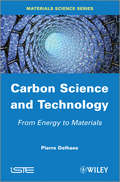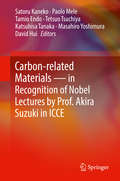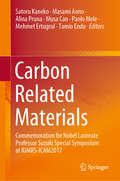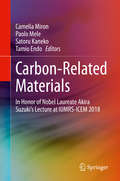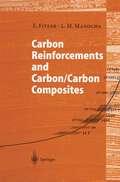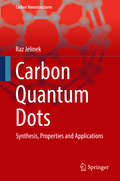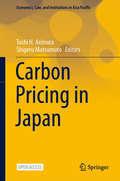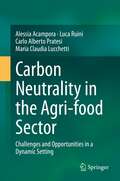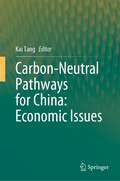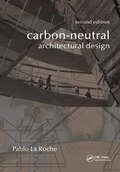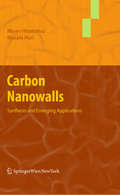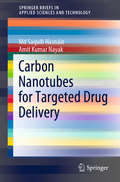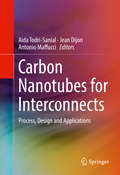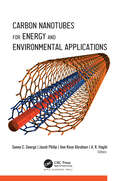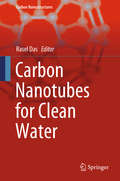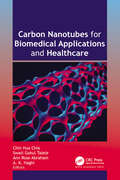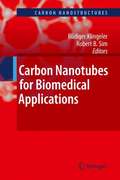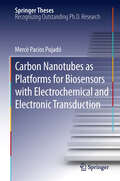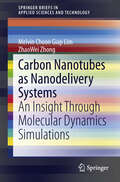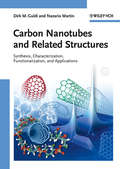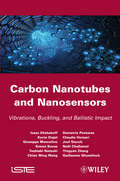- Table View
- List View
Carbon Science and Technology: From Energy to Materials
by Pierre DelhaesCarbon solids have been utilized by man since prehistoric times, first as a source of heat and then for other purposes; these are used as key markers for different civilizations. The essential role played by the use of coal mines during the industrial revolution as a main source of energy is a crucial point, which was then expanded through the development of carbochemistry. This book begins by describing the use of solid carbons as traditional materials, for example in the steel industry and for ceramics, then moving on to their technological uses such as active carbons and carbon fibers, etc., before discussing nanocarbons, the jewel in the crown of contemporary technological science. The final chapter analyzes the current economic and social impact of carbon solids.
Carbon-related Materials in Recognition of Nobel Lectures by Prof. Akira Suzuki in ICCE
by Satoru Kaneko Paolo Mele Tamio Endo Tetsuo Tsuchiya Katsuhisa Tanaka Masahiro Yoshimura David HuiThis book summarizes the recent advances in carbon-related materials. It covers both experimental and theoretical approaches in graphene and nanocarbon materials, carbon composites and thin films, organic synthesis and physical chemistry, and characterization tools. Also discussed are cutting-edge applications for use in biochemical assays, dental implant surface modifi cations, pressure sensors, and more. This book is published in recognition of the Nobel Lectures delivered by Akira Suzuki, Emeritus Professor of Hokkaido University and Nobel Prize winner in Chemistry, 2010.
Carbon Related Materials: Commemoration for Nobel Laureate Professor Suzuki Special Symposium at IUMRS-ICAM2017
by Satoru Kaneko Masami Aono Alina Pruna Musa Can Paolo Mele Mehmet Ertugrul Tamio EndoThis book commemorates the “Nobel Laureate Professor Suzuki Special Symposium” at the International Union of Material Research Society–International Conference on Advanced Materials (IUMRS-ICAM2017), which was held at Kyoto University, Japan, in 2017. The book begins with a foreword by Professor Akira Suzuki. Subsequently, many authors who attended the special symposium describe the latest scientific advances in the field of carbon materials and carbon nanomaterials including polymers, carbon nanocomposites, and graphene. Carbon-based materials have recently been the focus of considerable attention, given their wide range of potential applications. Fittingly, the chapters in this book cover both experimental and theoretical approaches in several categories of carbon-related materials.
Carbon-Related Materials: In Honor of Nobel Laureate Akira Suzuki’s Lecture at IUMRS-ICEM 2018
by Camelia Miron Paolo Mele Satoru Kaneko Tamio EndoThis book will give a detailed description of different carbon based materials synthesis methods, characterization, and applications. It serves as a fundamental information source on the actual techniques and methodologies involved in carbon materials synthesis, such as CVD, plasma in liquids, fusion reactors, or frequency-doubled yttrium–aluminum– garnet (YAG) lasers. This book includes coverage of several categories of carbon materials, such as graphene, carbon fiber composites, functionalized carbons, and polyimides used for various applications, from microelectronic industry to slotted waveguide antennas.
Carbon Reinforcements and Carbon/Carbon Composites
by E. Fitzer Lalit M. ManochaAdvanced composite materials have been a major research focus for the past forty years. As a reinforcement for conventional materials including glass, ceramics and polymers, carbon has proved to be the most successful. Carbon gives these materials flexibility so that they may be produced in bulk form with a wide variety of properties. Whereas carbon/carbon composites are the most effective materials in extreme temperature conditions. Application ranges from brakes to missile nose cones. Carbon Reinforcements and Carbon/Carbon Composites gives the present state on this subject in comprehensive form, as well as projections for other "High Tech" materials and their application.
Carbon Quantum Dots: Synthesis, Properties and Applications (Carbon Nanostructures)
by Raz JelinekThis book introduces the various aspects of the emerging field of carbon dots. Their structural and physico-chemical properties as well as their current and future potential applications are covered. A special chapter on graphene quantum dots is provided. The reader will also find different synthesis routes for carbon quantum dots.
Carbon Pricing in Japan (Economics, Law, and Institutions in Asia Pacific)
by Toshi H. Arimura Shigeru MatsumotoThis open access book evaluates, from an economic perspective, various measures introduced in Japan to prevent climate change. Although various countries have implemented such policies in response to the pressing issue of climate change, the effectiveness of those programs has not been sufficiently compared. In particular, policy evaluations in the Asian region are far behind those in North America and Europe due to data limitations and political reasons.The first part of the book summarizes measures in different sectors in Japan to prevent climate change, such as emissions trading and carbon tax, and assesses their impact. The second part shows how those policies have changed the behavior of firms and households. In addition, it presents macro-economic simulations that consider the potential of renewable energy. Lastly, based on these comprehensive assessments, it compares the effectiveness of measures to prevent climate change in Japan and Western countries.Providing valuable insights, this book will appeal to both academic researchers and policymakers seeking cost-effective measures against climate change.
Carbon Neutrality in the Agri-food Sector: Challenges and Opportunities in a Dynamic Setting
by Alessia Acampora Luca Ruini Carlo Alberto Pratesi Maria Claudia LucchettiThis book deals with the in-depth study of sustainability issues in the agri-food sector. In particular, a critical analysis of the current situation was developed and the future prospects of the sector on the issue of managing the environmental variable and the impacts relating to food production and consumption have been analyzed. Furthermore, the state of implementation and best practices relating to the carbon neutrality model in the agri-food sector were analyzed and models for the development of a new food production system were proposed with particular reference to the reduction of emissions, regeneration of natural resources, the elimination of waste and the reuse of production by-products. The main objectives of the book are to analyze the current situation and trends regarding carbon neutrality schemes and the connection with other greening programs, to identify and analyze the carbon-related labels, their methodology and their conformity assessment mechanisms and to understand possible key drivers for carbon neutrality or low carbon achievements in the agri-food sector.Today companies are acting on climate change pressures implementing carbon-neutral strategies for their brands and products. These frontrunner companies have identified a specific competitive advantage and are exploiting it to become the pioneers and the reference model for the carbon neutral implementation. This book will provide detailed and practical insights on how your organization can take positive action and be part of the global response developing a carbon neutral business.
Carbon-Neutral Pathways for China: Economic Issues
by Kai TangThis book provides comprehensive economic analyses on the paths to net-zero for China. It gives a detailed overview of issues and challenges related to carbon neutrality of the global largest emitter which have not been adequately addressed e.g., reduction costs and efficiency of existing actions, the multiple impacts of the newly established carbon market, and the potentials and costs of nature-based solutions such as biophysical sequestration, etc. Studies on China’s carbon reduction have attracted scientists and policymakers from diverse backgrounds. Pursuing a holistic and systematic approach, the book establishes a fundamental framework for this topic, emphasizing the importance of integrated technical-economic-policy analysis. This book will not only be an essential reference to the carbon-neutral progress in China but also will be an outstanding text book on carbon-neutral management. Similarly, this book is expected to attract a great range of readership including undergraduate and postgraduate students, economic and climate specialists, researchers and policymakers in China as well as in overseas.
Carbon-Neutral Architectural Design
by Pablo M. La RocheThe energy used to operate buildings is one of the most significant sources of greenhouse gas emissions. While it is possible to reduce emissions through climate-responsive design, many architects are not trained to do this. Filling an urgent need for a design reference in this emerging field, this book describes how to reduce building-related greenhouse gas emissions through appropriate design techniques. It presents strategies to achieve CO2 reductions, with an emphasis on control of energy flows through the building envelope and passive heating and cooling strategies. This new, revised edition is updated throughout, and includes a new chapter on building simulations.
Carbon-Neutral Architectural Design
by Pablo M. La RocheThe energy used to operate buildings is one of the most significant sources of greenhouse gas emissions. While it is possible to reduce emissions through climate-responsive design, many architects are not trained to do this. Filling an urgent need for a design reference in this emerging field, this book describes how to reduce building-related greenhouse gas emissions through appropriate design techniques. It presents strategies to achieve CO2 reductions, with an emphasis on control of energy flows through the building envelope and passive heating and cooling strategies. This new, revised edition is updated throughout, and includes a new chapter on building simulations.
Carbon Nanowalls: Synthesis and Emerging Applications
by Mineo Hiramatsu Masaru HoriRepresenting the first text to cover this exciting new area of research, this book will describe synthesis techniques of CNWs, their characterization and various expected applications using CNWs. Carbon-nanowalls (CNWs) can be described as two-dimensional graphite nanostructures with edges comprised of stacks of plane graphene sheets standing almost vertically on the substrate. These sheets form a wall structure with a high aspect ratio. The thickness of CNWs ranges from a few nm to a few tens of nm. The large surface area and sharp edges of CNWs may prove useful for a number of applications such as electrochemical devices, field electron emitters, storage materials for hydrogen gas, catalyst support. In particular, vertically standing CNWs with a high surface-to-volume ratio, serve as an ideal material for catalyst support for fuel cells and in gas storage materials.
Carbon Nanotubes: From Basic Research to Nanotechnology (NATO Science Series II: Mathematics, Physics and Chemistry #222)
by Valentin N. Popov Philippe LambinIt is about 15 years that the carbon nanotubes have been discovered by Sumio Iijima in a transmission electron microscope. Since that time, these long hollow cylindrical carbon molecules have revealed being remarkable nanostructures for several aspects. They are composed of just one element, Carbon, and are easily produced by several techniques. A nanotube can bend easily but still is very robust. The nanotubes can be manipulated and contacted to external electrodes. Their diameter is in the nanometer range, whereas their length may exceed several micrometers, if not several millimeters. In diameter, the nanotubes behave like molecules with quantized energy levels, while in length, they behave like a crystal with a continuous distribution of momenta. Depending on its exact atomic structure, a single-wall nanotube –that is to say a nanotube composed of just one rolled-up graphene sheet– may be either a metal or a semiconductor. The nanotubes can carry a large electric current, they are also good thermal conductors. It is not surprising, then, that many applications have been proposed for the nanotubes. At the time of writing, one of their most promising applications is their ability to emit electrons when subjected to an external electric field. Carbon nanotubes can do so in normal vacuum conditions with a reasonable voltage threshold, which make them suitable for cold-cathode devices.
Carbon Nanotubes for Targeted Drug Delivery (SpringerBriefs in Applied Sciences and Technology)
by Md Saquib Hasnain Amit Kumar NayakThis book provides a detailed introduction to carbon nanotubes (CNTs) for targeted drug delivery. After a brief overview of the classification, preparation, and characterization of carbon nanotubes, it focuses on their use in targeted drug delivery. It presents CNTs for brain targeting, ocular targeting, cancer targeting, and lymphatic targeting, as well as antibody therapy. The book also includes chapters on carbon nanotubes for controlled drug delivery, transdermal drug delivery, solubility enhancement, vaccine delivery, gene delivery, and as quantum dots. Last but not least, it addresses the absorption and transportation of CNTs, toxicity and regulatory considerations, as well as clinical trials and the market status of CNTs. The book offers a comprehensive, self-contained reference guide, with all topics covered concisely and with the help of figures, tables and flowcharts.
Carbon Nanotubes for Interconnects: Process, Design and Applications
by Aida Todri-Sanial Jean Dijon Antonio MaffucciThis book provides a single-source reference on the use of carbon nanotubes (CNTs) as interconnect material for horizontal, on-chip and 3D interconnects. The authors demonstrate the uses of bundles of CNTs, as innovative conducting material to fabricate interconnect through-silicon vias (TSVs), in order to improve the performance, reliability and integration of 3D integrated circuits (ICs). This book will be first to provide a coherent overview of exploiting carbon nanotubes for 3D interconnects covering aspects from processing, modeling, simulation, characterization and applications. Coverage also includes a thorough presentation of the application of CNTs as horizontal on-chip interconnects which can potentially revolutionize the nanoelectronics industry. This book is a must-read for anyone interested in the state-of-the-art on exploiting carbon nanotubes for interconnects for both 2D and 3D integrated circuits.
Carbon Nanotubes for Energy and Environmental Applications
by Soney C. George Jacob Philip Ann Rose Abraham A. K. HaghiThis new book, Carbon Nanotubes for Energy and Environmental Applications, covers the timely issue of green applications of carbon nanotubes. It covers the diverse usages of carbon nanotubes for the sensing of environmentally hazardous chemicals, for water purification, for the protection of the environment, and for new energy applications. The development of highly sensitive CNT-based gas sensors for air pollution monitoring, for green synthesis of carbon nanotubes, and for green energy applications are discussed in this volume. The diverse topics in the volume include nanodiamonds for energy storage, new lubricant additives that enhance energy efficiency, how carbon nanotubes can be applied in the food and agricultural sectors, the use of CNTs in water purification and desalination, carbon nanotubes-based electrochemical sensors for environmentally hazardous chemicals, and much more. This timely book addresses a need of the hour and will provide valuable for environmentally conscious industry professionals, faculty and students, and researchers in materials science, engineering, physics, and chemistry with interest in nanomaterials.
Carbon Nanotubes for Energy and Environmental Applications
by Soney C. George Jacob Philip Ann Rose Abraham A. K. HaghiThis new book, Carbon Nanotubes for Energy and Environmental Applications, covers the timely issue of green applications of carbon nanotubes. It covers the diverse usages of carbon nanotubes for the sensing of environmentally hazardous chemicals, for water purification, for the protection of the environment, and for new energy applications. The development of highly sensitive CNT-based gas sensors for air pollution monitoring, for green synthesis of carbon nanotubes, and for green energy applications are discussed in this volume. The diverse topics in the volume include nanodiamonds for energy storage, new lubricant additives that enhance energy efficiency, how carbon nanotubes can be applied in the food and agricultural sectors, the use of CNTs in water purification and desalination, carbon nanotubes-based electrochemical sensors for environmentally hazardous chemicals, and much more. This timely book addresses a need of the hour and will provide valuable for environmentally conscious industry professionals, faculty and students, and researchers in materials science, engineering, physics, and chemistry with interest in nanomaterials.
Carbon Nanotubes for Clean Water (Carbon Nanostructures)
by Rasel DasThis book presents carbon nanotubes as a potential material for the development of new waste water treatment technologies. Reviews on adsorption, catalysis, membrane, filtration and desinfection methods are provided. A special chapter presents the use of carbon nanotubes to sense and monitor water pollutants. The text underlies each technology and process as well as the current commercialization efforts. Research gaps are highlighted at the end with links to further reading material in the field.
Carbon Nanotubes for Biomedical Applications and Healthcare
by Chin Hua Chia Swati Gokul Talele Ann Rose Abraham A. K. HaghiRecent advancements and research in nanotechnology, biotechnology, materials engineering the applications of nanomaterial are evolving. Carbon nanotubes (CNT) and CNT-based systems possess unique chemical, physical, and biological properties that make them good candidates in biomedical applications, but they also have some inherent properties that cause great concern about their biosafety. This volume explores the practical applications of carbon nanotubes in biomedical science and human health. It discusses the synthesis, properties, modification, and recent progress of carbon nanotubes and their applications for biosensing, cancer treatment, antibacterial therapy, tissue engineering, targeted drug delivery, and toxicity. It relays the potential and promise of carbon-based nanomaterials for host of applications while also looking at the challenges in synthesis, characterization, and applications of nanomaterials and how to overcome them.
Carbon Nanotubes for Biomedical Applications and Healthcare
Recent advancements and research in nanotechnology, biotechnology, materials engineering the applications of nanomaterial are evolving. Carbon nanotubes (CNT) and CNT-based systems possess unique chemical, physical, and biological properties that make them good candidates in biomedical applications, but they also have some inherent properties that cause great concern about their biosafety. This volume explores the practical applications of carbon nanotubes in biomedical science and human health. It discusses the synthesis, properties, modification, and recent progress of carbon nanotubes and their applications for biosensing, cancer treatment, antibacterial therapy, tissue engineering, targeted drug delivery, and toxicity. It relays the potential and promise of carbon-based nanomaterials for host of applications while also looking at the challenges in synthesis, characterization, and applications of nanomaterials and how to overcome them.
Carbon Nanotubes for Biomedical Applications (Carbon Nanostructures)
by Rüdiger Klingeler Robert B. SimThis book explores the potential of multi-functional carbon nanotubes for biomedical applications. It combines contributions from chemistry, physics, biology, engineering, and medicine. The complete overview of the state-of-the-art addresses different synthesis and biofunctionalisation routes and shows the structural and magnetic properties of nanotubes relevant to biomedical applications. Particular emphasis is put on the interaction of carbon nanotubes with biological environments, i.e. toxicity, biocompatibility, cellular uptake, intracellular distribution, interaction with the immune system and environmental impact. The insertion of NMR-active substances allows diagnostic usage as markers and sensors, e.g. for imaging and contactless local temperature sensing. The potential of nanotubes for therapeutic applications is highlighted by studies on chemotherapeutic drug filling and release, targeting and magnetic hyperthermia studies for anti-cancer treatment at the cellular level.
Carbon Nanotubes as Platforms for Biosensors with Electrochemical and Electronic Transduction (Springer Theses)
by Mercè Pacios PujadóThe thesis by Mercè Pacios exploits properties of carbon nanotubes to design novel nanodevices. The prominent electrochemical properties of carbon nanotubes are used to design diverse electrode configurations. In combination with the chemical properties and (bio)functionalization versatility, these materials prove to be very appropriate for the development of electrochemical biosensors. Furthermore, this work also evaluates the semiconductor character of carbon nanotubes (CNT) for sensor technology by using a field effect transistor configuration (FET). The CNT-FET device has been optimized for operating in liquid environments. These electrochemical and electronic CNT devices are highly promising for biomolecule sensing and for the monitoring of biological processes, which can in the future lead to applications for rapid and simple diagnostics in fields such as biotechnology, clinical and environmental research.
Carbon Nanotubes as Nanodelivery Systems: An Insight Through Molecular Dynamics Simulations (SpringerBriefs in Applied Sciences and Technology)
by Melvin Choon Lim ZhaoWei ZhongThis book showcases the application of carbon nanotubes as nanodelivery systems for copper atoms, using molecular dynamics simulations as a means of investigation. The nanodelivery system of the carbon nanotube presents the possible usage of the carbon structure in many areas in the future. This book is comprehensive and informative, and serves as a guide for any reader who wishes to perform a molecular dynamics simulation of his own and to conduct an analytical study of a molecular system.
Carbon Nanotubes and Related Structures: Synthesis, Characterization, Functionalization, and Applications
by Dirk M. Guldi Nazario Martín Nazario Mart 237 NWritten by the most prominent experts and pioneers in the field, this ready reference combines fundamental research, recent breakthroughs and real-life applications in one well-organized treatise. As such, both newcomers and established researchers will find here a wide range of current methods for producing and characterizing carbon nanotubes using imaging as well as spectroscopic techniques. One major part of this thorough overview is devoted to the controlled chemical functionalization of carbon nanotubes, covering intriguing applications in photovoltaics, organic electronics and materials design. The latest research on novel carbon-derived structures, such as graphene, nanoonions and carbon pea pods, round off the book.
Carbon Nanotubes and Nanosensors: Vibration, Buckling and Balistic Impact (Iste Ser.)
by Isaac Elishakoff Kevin Dujat Giuseppe Muscolino Simon Bucas Toshiaki Natsuki Chien Ming Wang Demetris Pentaras Claudia Versaci Joel Storch Noël Challamel Yingyan Zhang Guillaume GhyselinckThe main properties that make carbon nanotubes (CNTs) a promising technology for many future applications are: extremely high strength, low mass density, linear elastic behavior, almost perfect geometrical structure, and nanometer scale structure. Also, CNTs can conduct electricity better than copper and transmit heat better than diamonds. Therefore, they are bound to find a wide, and possibly revolutionary use in all fields of engineering.The interest in CNTs and their potential use in a wide range of commercial applications; such as nanoelectronics, quantum wire interconnects, field emission devices, composites, chemical sensors, biosensors, detectors, etc.; have rapidly increased in the last two decades. However, the performance of any CNT-based nanostructure is dependent on the mechanical properties of constituent CNTs. Therefore, it is crucial to know the mechanical behavior of individual CNTs such as their vibration frequencies, buckling loads, and deformations under different loadings.This title is dedicated to the vibration, buckling and impact behavior of CNTs, along with theory for carbon nanosensors, like the Bubnov-Galerkin and the Petrov-Galerkin methods, the Bresse-Timoshenko and the Donnell shell theory.
